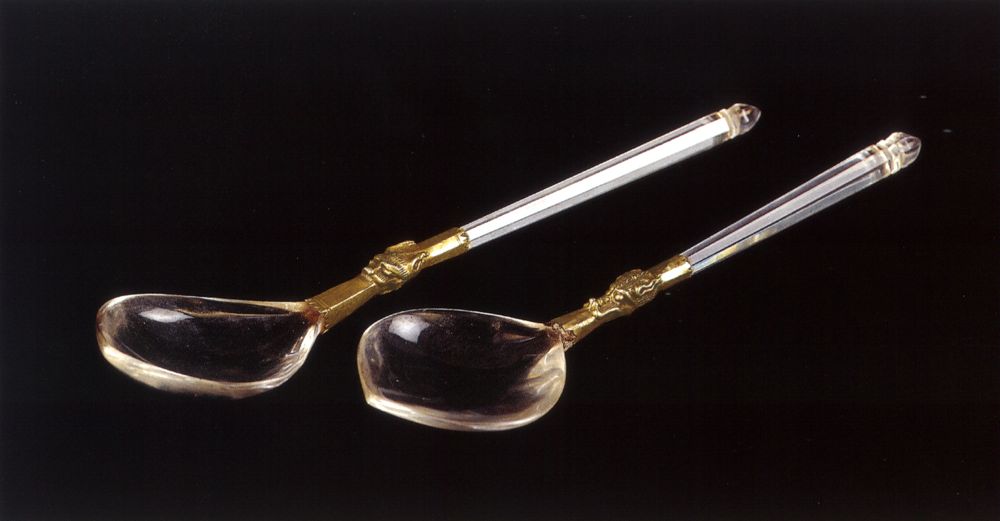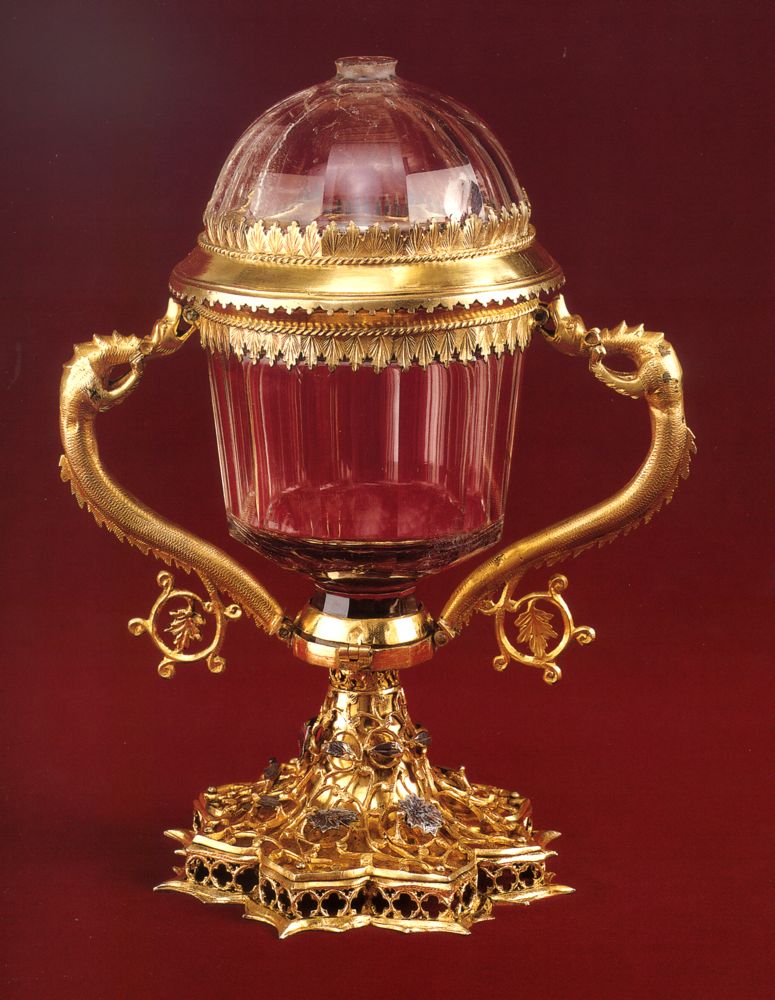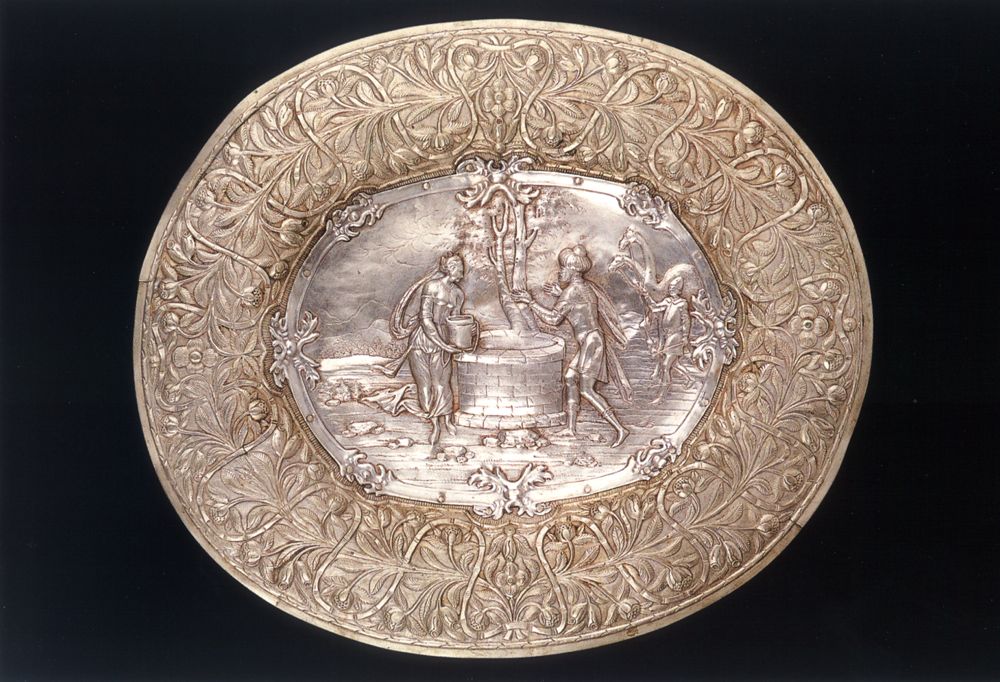Works from Foreign Workshops 14th-16th century
3 November 2011A separate category of objects is made up of a very few – but important – works of Western or Eastern art, representing goldsmiths of renown or workshops of repute. Made out of material rare for the period, they give a distinctive quality of a treasury to the sacristy, which, like the treasuries of the princes of the West or the East, contains examples of priceless or exotic art.
The spoons of rock crystal, referred to in the catalogue of sacred vessels of 1749 as “marvellous crystal spoons: two”, are rarities.
In Western Europe in the Middle Ages, spoons were items of personal property, which, when made of precious materials, were intended for the nobility and senior clergy. The joint of the faceted handle with the shallow pointed bowl is covered with gilded metal which takes the surprising form of a dragon with a crest and a row of nostrils in the form of dots. Similar dragons are to be found on two silver spoons of the 14th century from the so-called Rouen Treasure, while they are mentioned in written sources of the first half of the 15th century. The handle is tipped with a sharp prismatic knob, reminiscent of a diamond, a feature in which, together with the shape, it resembles older silver spoons of the 14th century, many of them of French origin.
Amongst the most striking works in the sacristy is the reliquary in the shape of a cup made of rock crystal with a silver gilt mount and handles in the shape of dragons.
Typical Venetian work, it has a deep cylindrical bowl with a hemispherical cover carved with gentle ribbing, to reflect and bring out the precious material of which it is made.
The mount consists of the high foot with its eight-lobed base, resting on an openwork foot-ring, the handles in the shape of dragons, and the row of acanthus leaves which adorns the rim and the base of the cover. The finial is missing from the top of the cover. A separately-made plant interlace decorates the foot and forms a second level of spiralling stems with vine leaves, on which traces of enamel can be seen. A similar setting is encountered in a reliquary of rock crystal in the Cathedral of Stara Boleslav, which in its original form had a handle in the shape of a dragon and is dated to the first half of the 14th century. Of the same period, but with a simpler plant pattern without leaves is a reliquary in a parish church in Düsseldorf, which retains its dragon handle. This type of decoration is regarded as a development of the opus Venetum ad filum, and in the earlier works of the 13th century the scrolls, made out of silver sheetmetal sheeting, are combined with animal forms, while in the 14th century the emphasis was on foliage. This trend seems to follow the later evolution of Venetian silversmithing as seen in the works of the famous ‘Master of the Serpentine’ (1325-1350), its chief characteristic being the large repoussé vine leaves on scrolls, which as they spiral form knots. The comparison can be made particularly clear in the dragons’ tails on the Vatopaidi cup; these have a similar leaf, surrounded by a knotted stem. This type of mounting, however, is not found exclusively within the chronological limits of the middle years of the 14th century. The acanthus leaves, for example, are encountered in works from the second half of the century, while two reliquaries from the treasury of the Medici, with more composite dragon handles, are dated to the end of the same century or the beginning of the 15th. The circular stamp of St Mark, together with the workshop mark, with which the Vatopaidi reliquary is hallmarked confirm that it is a work of the early 15th century.
In manuscripts of the 18th century there are references to the crystal vessel which is described as a “krateter” and is believed to have been the gift of Andronicus Palaeologus. Thus the catalogue of sacred vessels of 1749 describes it as “a crystal cup of andronicus the king”. A proskynetarion* written around 1728 states that Andronicus donated “another krateter cup and it is of finest crystal and of great price”, while in the ‘patria’, the historical memorabilia of the Monastery, of 1740 we read that Andronicus gave, apart from “the cup of jasper”, “another krateter cup”. This tradition, later repeated by Porfirij Uspenskij, does not seem, on the basis of the present state of knowledge, to be older than the 16th century and does not receive support from the dating of the object9. The interesting description of the vessel as a krateter must come from a meaning, rarely encountered, applied to an ecclesiastical vessel held (kratein = to hold) by handles.
It is from an alien cultural world that the small stemmed cup shown in Fig. 443 is derived. The translucent green glaze is the distinguishing mark of Chinese stoneware, the renowned celadons of the Lung-ch’üan workshops. The fine stem with the undulating contour, derived from metal vessels, has the archaising character which was usual in the 14th century, the period of the Yüan dynasty, while the somewhat unclear carved plant designs suggest an object in daily use, and one probably produced in the early Ming period, that is, the late 14th and the 15th century. In the early 17th century, the stem was lengthened by means of a gilt mounting decorated with nailed medallions which contain an Ottoman floral arabesque on a niello background. A curved band with bilobed leaves is formed where it joins the ceramic. The mount in effect changes the shape of the object, a practice frequently applied to the Chinese porcelains of the Topkapi. The treasury of the Sultans and that of the Ardabil mosque in Persia constitute the largest concentrations of Chinese porcelain outside China. The admiration felt by the Muslim world for Chinese ceramics led to attempts to imitate them as early as the 9th century, while in the 14th exportation from China to the Middle East took place on a large scale. Muslim writers of the 13th century attributed healing properties and protection against poisons to porcelain, and this belief, applying especially to celadons, was brought to the West by European travellers in the 16th century. The unknown donor of the Vatopaidi cup could have obtained it in the markets of Constantinople, Cairo, or other centres of the Middle East, and certainly would have had in mind, as would the monks, its medicinal properties. Nevertheless, in the inventories of the sacristy it is described simply as a “farfouri” (1748), that is, porcelain, and probably it is what is meant by “a green stone cup with a silver bottom” (1749). It should, however, be noted that therapeutic properties were ascribed, in the East and West alike, to all wonderful, exotic and mythical materials. A typical example of this is the reference in the catalogue of the sacristy of 1749 to a cup of unicorn horn “made with mixtures beneficial for every sickness”.
The oval-shaped plate shown has a small opening in the back which betrays the fact that it is made from two pieces, the bottom and the plate itself.
The broad, slightly curved, rim has rich baroque floral decoration in the typical style of the Augsburg workshops of the second half of the 17th century. The trouble taken to incorporate the bottom part into the plate is to be explained by the fact that it is an earlier piece from the Augsburg workshops and comes from the bottom decoration of a tazza, that is, the typical Mannerist vessels with a shallow bowl resting on a high foot. When there ceased to be a market for them, it became the custom to cut out the decoration of the bowl, since it was usually exceptionally elaborate, the work of famous craftsmen, and either re-use or employ it to produce the lead dies which were a basic tool of the craftsmen of the time in the reproduction of motifs. This particular scene reproduces, or is, the work of the famous goldsmith Paul Hübner of Augsburg, who around 1590 produced 60 vessels of a similar shape. A series of these, today in Florence, have on their bottom scenes from the Old Testament, among them that of the meeting of Rebekah and Eliezer at the well.









